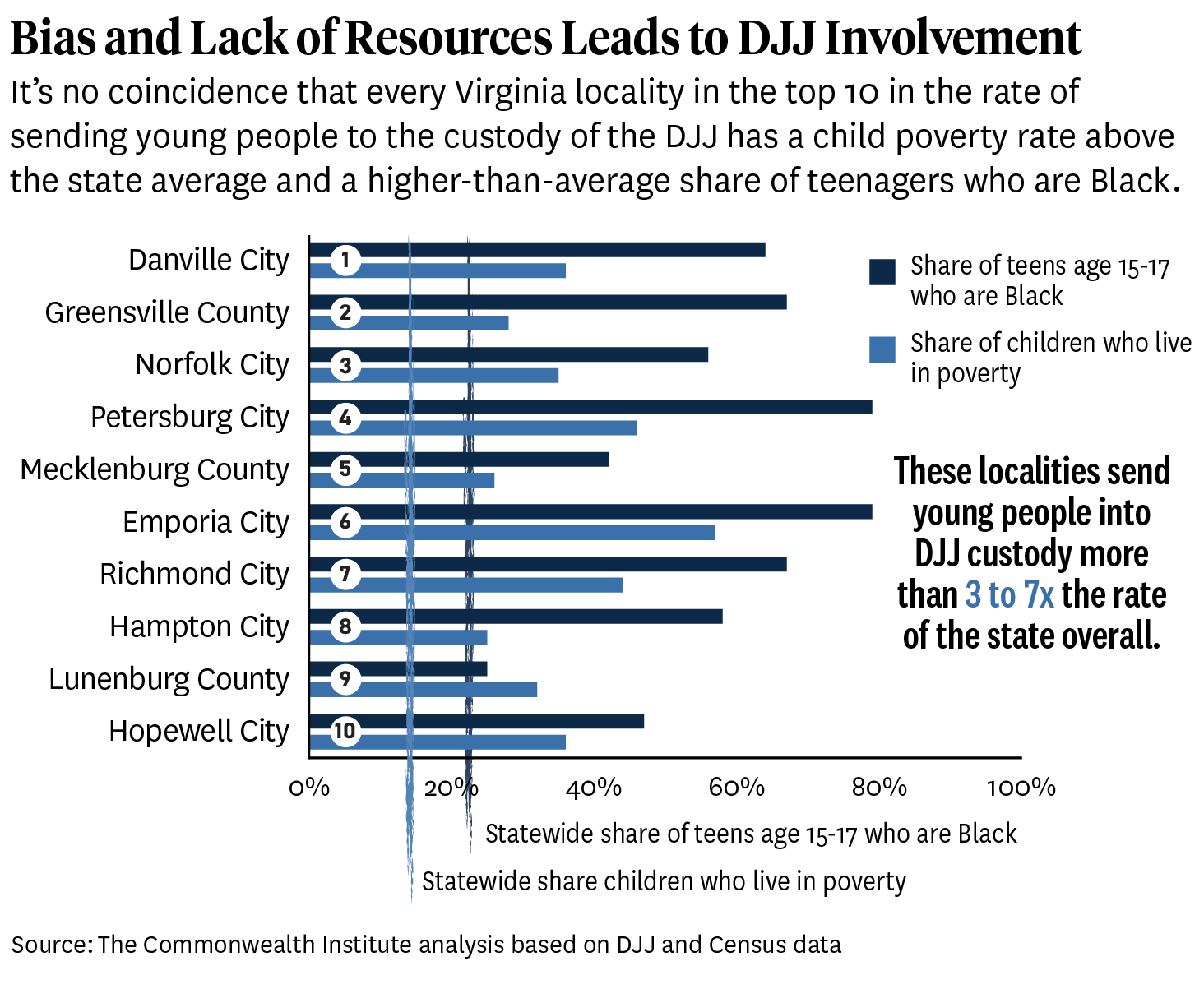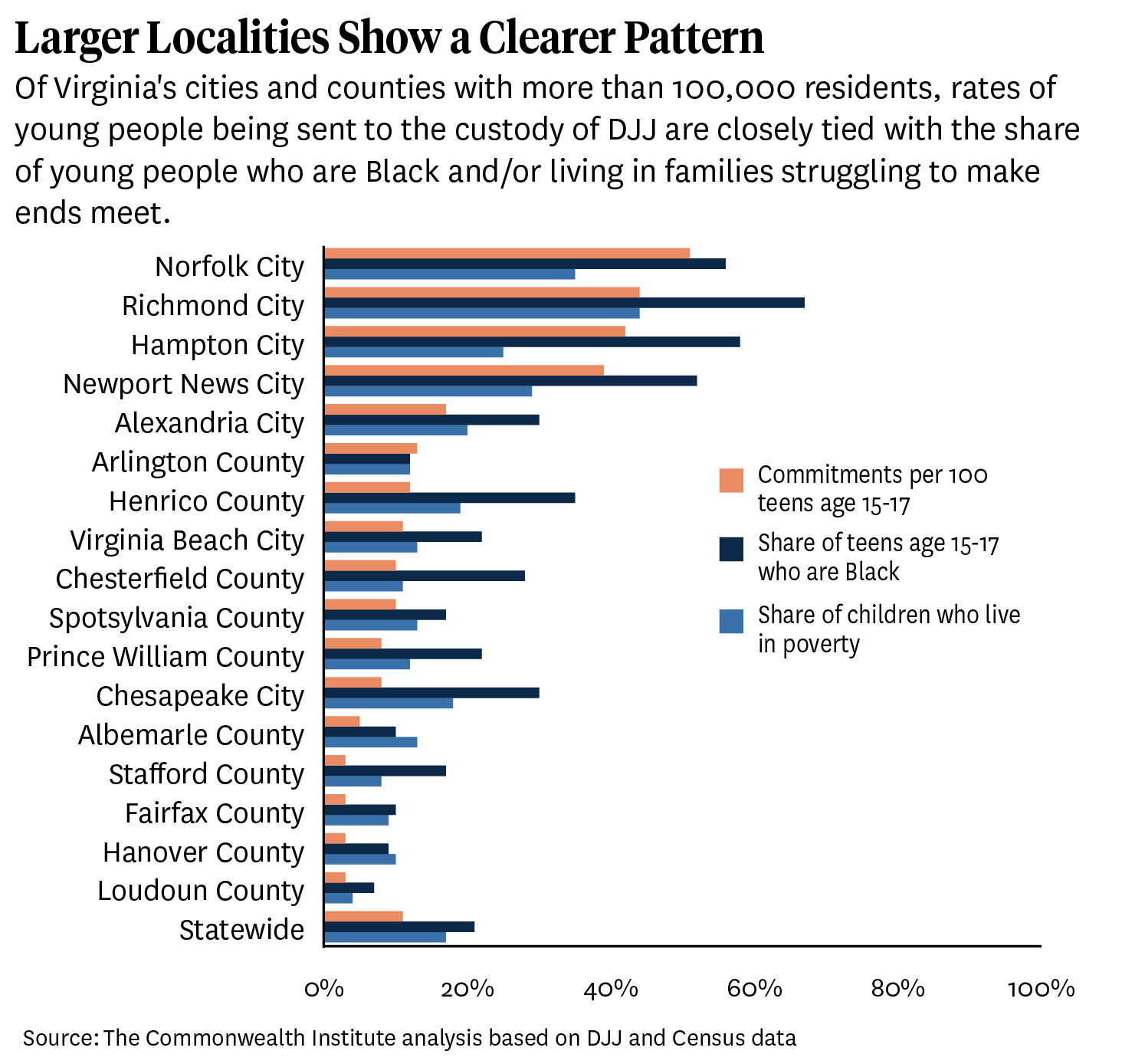November 12, 2019
Ending the Cycle of Incarceration for Black Youth
This is a joint report of The Commonwealth Institute and RISE for Youth; co-authored by Gary Broderick and Valerie Slater.
Schools and communities should be places where every child is valued, nurtured, and challenged to succeed, and where children’s misbehavior is appropriately addressed without treating kids like criminals. There has been a lot of focus on the need to stop the school-to-prison pipeline, and the latest data shows that things are changing — for some children. During the 2016-2017 school year, the overall rate of out-of-school suspensions fell slightly from the prior year, yet the suspension rate for Black students was 4.5 times higher than for Hispanic and White students — up from 3.8 times higher the prior school year. Similarly, the pace at which Virginia courts send White young people to the deep end of the incarceration system — the custody of the state Department of Juvenile Justice (DJJ) — is down 20% in 2018 from fiscal year 2017. But at the same time, Virginia courts increased the rate of sending Black young people into the deep end of the incarceration system by 3%. Virginia legislators can and should take steps to reverse this troubling trend and build healthy communities where young people can get the help they need to get back on track.
Twenty-one percent of Virginia teens age 15 to 17 are Black, yet 57% of young people suspended from school, 49% of young people reported to juvenile courts by school authorities, 42% of young people reported to juvenile intake officers, 54% of young people detained in local youth jails, and 72% of young people sent to the custody of the DJJ are Black.
These are not disconnected facts: children who are suspended from school in Virginia are more likely to experience academic failure, drop out of school, have substance abuse issues, have mental health needs, and become involved in the justice system.
Virginia’s historic and ongoing racial discrimination in housing and employment opportunities means many young Black Virginians grow up in neighborhoods and communities that struggle to provide the resources that every young person needs to thrive.
And Virginia’s historic and ongoing racial discrimination in housing and employment opportunities means many young Black Virginians grow up in neighborhoods and communities that struggle to provide the resources that every young person needs to thrive. With high exposure to trauma and insufficient funding for school-based supports such as school counselors, plus racial bias that leads to Black youth being seen as more threatening than White youth, too many young Black Virginians end up getting pushed out of school and into contact with law enforcement.
It’s no coincidence that every Virginia locality that’s in the top 10 in their rate of sending young people to the custody of the DJJ has a child poverty rate above the state average and a higher-than-average share of teenagers who are Black.

Looking just at Virginia’s largest localities, where there is less likely to be a major impact from year-to-year fluctuations, the ways that young people from cities where most children are Black and many children live in families who are struggling to make ends meet are most likely to be sent to the custody of the DJJ becomes even clearer.

Helping families with low incomes overcome barriers to bringing home enough to support their families is an important part of addressing the high rate of incarceration of young people from cities and counties where many of their peers are Black and low-income. Yet differences in income is not the full story. There is a stronger correlation in Virginia between the share of young people who are Black and a city or county’s rate of young people being committed to the custody of DJJ than there is between the poverty rate and commitment rates. As a result, 72.2% of young people who are being held by the state DJJ are Black.
By reforming discipline policies and investing in strong schools and strong communities, policymakers can help young people thrive
Virginia can and should invest in uplifting communities and dismantling barriers facing Black families. These barriers were created by bias and unjust systems, meant to disenfranchise and defund Black communities, and include low wages, lack of access to neighborhoods of opportunity, underfunded schools, and high levels of policing in Black communities. Virginia’s high rates of incarcerating Black young people are the result of both past and present public policy choices, and today’s policymakers can make choices to end this Jim Crow juvenile justice.
Supportive services should be available to struggling young people and their families without going through the incarceration system. Virginia’s General Assembly took a step in the right direction during 2019 with a bipartisan bill (HB1771) that expanded access to services funded through the Virginia Juvenile Community Crime Control Act (VJCCCA). As a next step, state and local policymakers should make sure young people can be served directly by community-based providers rather than requiring interactions with court service units, and should provide training to make sure service providers that are connected with and trusted by families in neighborhoods most touched by youth incarceration are able to take the lead on helping young people get back on track. And state policymakers should adequately fund these expanded community-based services. State support for community-based services through the VJCCCA is down 28% compared to fiscal year 2007, making it harder for less wealthy city and county governments to maintain even existing services.
School counselors, social workers, psychologists, and nurses play essential roles in meeting the mental health needs of students, keeping all students safe, reducing the use of exclusionary discipline, and helping students achieve academic and career success. Yet over the past decade in Virginia, the number of school counselors, librarians, and support staff has fallen, while overall student enrollment has grown — and the number of economically disadvantaged students who can benefit most from their services has increased dramatically. The number of school counselors alone has decreased by 527 positions, and their caseloads have grown significantly. The number of students per school counselor has increased from 300 students in 2007-2008 to 361 students in 2017-2018, well above the Virginia Board of Education- and nationally-recommended staffing requirement of one counselor for every 250 students. Schools with lower student-to-counselor ratios have lower suspension rates, and studies have shown this to be especially true in high-poverty schools. In Virginia, where students of color make up a large share of students in high-poverty schools, providing adequate state funding to improve school counselor caseloads could help address the racial disparities in suspensions, expulsions, and police referrals.
School counselors, social workers, psychologists, and nurses play essential roles in meeting the mental health needs of students, keeping all students safe, reducing the use of exclusionary discipline, and helping students achieve academic and career success.
And keeping youth safely in their communities and closing Virginia’s outdated youth prisons would help young people who have gotten into trouble get connected with positive role models and pathways, rather than separating them from society. Investing in positive organizations and service providers that are genuinely grounded in low-income Black communities, rather than spending so much money on the heavy policing of these neighborhoods and the incarceration of so many Black children and adults, would provide immediate relief for families struggling to survive in communities that are still carrying the legacy of red lining, displacement through “urban renewal” schemes, and a two-tier discriminatory job market. This can be done through a re-prioritization at the local and state levels, and should include a commitment to ending the incarceration of children in prison-like juvenile correctional centers. It costs Virginia $187,473 to lock up a child for a year at the Bon Air Juvenile Correctional Center, money that could be far better used to help communities keep their children safely at home. And in the long term, strengthening communities will help every young person be able to reach their full potential, which will pay dividends for generations.
For the small number of young people who cannot remain in their homes, placements that are small and close to the young person’s home community would help maintain ties and ensure a successful transition back to regular life. The Healthy Communities Secure Care legislation would set Virginia on this path by shifting any out-of-home placements to smaller facilities with a maximum of 30 young people close to the young person’s family. Smaller juvenile correction centers ensure an environment where youth know all their peers and administrators. That reduction in anonymity and associated isolation reduces the likelihood of violence and increases the chance for trust building among peers and between peers and administrators. This trust is critical to ensuring a rehabilitative process that promotes the mental health of the youth and public safety. And when young people are housed in their communities, they are able to maintain important social relationships, remain engaged with their school work, and interact with staff they understand to be part of their community — all of which reduce recidivism.
The most important reason to shift away from large prison-like correctional centers and towards smaller, community-based facilities is to increase safety and positive outcomes for young people, their families, and their communities. Yet there are also potential cost savings in the long run if carried out properly. Running youth prisons is very expensive. For example, DJJ regulations governing juvenile correctional centers (JCCs) currently require that each JCC have an on-site medical room (6VAC35-71-410) and “a control center that integrates all external and internal security functions and communications, is secured from residents’ access, and is staffed 24 hours a day” (6VAC35-71-470). And when young people live in community-based settings, they can receive needed services such as medical care at regular doctors offices. By contrast, youth prisons, as closed-off environments, typically require all services to be provided in-house, including all medical, mental health, and education. And DJJ’s plans for smaller JCCs have included staffed gate houses and on-site full-time support staff in addition to other security and counseling staff, resulting in a high per-youth, per-day cost (in one iteration of the proposal, the cost would be $568 per youth, per day, assuming 100% occupancy). These costs would be even higher if they were spread over a smaller number of young people in smaller facilities. Other states such as Missouri have saved money and seen better outcomes by providing intensive youth development by dedicated youth development specialists rather than correctional supervision by guards. Using the Missouri secure site per diem costs, adjusted for Virginia’s higher salary costs, maintenance, and medical costs, might cost about $375 per youth, per day. At the higher end, but still lower-cost than operating mini youth prisons, there are very intensive residential treatment centers for youth in Virginia whose total costs, including educational costs, are about $500 per youth/per day. In other words, youth correctional centers can be operated with fewer costs if they are not treated as mini prisons.
For 400 years, public policy has too often been used to erect barriers for communities of color, with the frequent effect of also harming low-income White communities. And that needs to change. Every new investment, funding cut, and change in policy language represents a decision about what and who Virginia values. We can do better.
